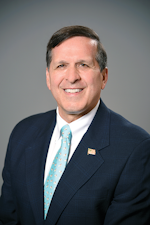The COVID-19 crisis is an unprecedented event, and the information surrounding it changes daily. In a crisis of this nature where a great deal is unknown, it is difficult to manage your business through it and create a plan for recovery. Since the beginning of March, we here at Levin Group have spoken to hundreds of dentists, participated in webinars with thousands of participants, and continually evaluated options for practices to enter the recovery stage. This article will focus on recovery from the COVID-19 crisis and practical steps practices can take that will allow them to bounce back faster and better.
3 stages of COVID-19
In order to better understand how practices will be able to recover, we categorized the COVID-19 crisis into three stages. They are:
• Stage 1: The COVID-19 crisis
• Stage 2: Entering recovery
• Stage 3: Recovery
Stage 1: The COVID-19 crisis
As I write this article, we are in Stage 1. For the most part, dental offices are closed other than those providing emergency care, depending on state regulations. Most doctors are home and heavily focused on expenses, employees and employment options, cash, and the future. Even in areas of the country where practices may be seeing patients, it is not business as usual. There is a great deal of anxiety and concern and many dentists are unsure of what steps to take. However, in these uncertain times dental practices have little room for uncertainty. Planning needs to take place now for a practice to be completely prepared for entering the next stage.
In a sense, the situation that dental practices are in sets the stage for a business turnaround. Revenue has been lost, patients have gone unscheduled, staff may be terminated or furloughed, and the economy will take time to restart. This makes planning difficult, but there are certain strategies that can be put in place now that will put the practice on good footing. Practices that have a well-thought-out plan that is implemented quickly and at the right time will be the ones to bounce back faster and better. Strategies can be launched as soon as possible.
Recommendations that can take place in Stage 1
Stay close to your staff. Your dental team has the same anxieties, concerns, and fears as most Americans today. Whether they have been terminated, furloughed, rehired, or left sitting at home waiting for the practice to reopen, they’re uncertain about their futures. Therefore, it’s important to stay close to your team. If they’re not together in the practice, dentists should be talking to team members once or twice a week. This is a time for leadership, and leadership is about compassion. Call team members just to say hello, be a friend, check in, and provide emotional support. But be sure to be honest. Don’t be afraid to say “I don’t know” when asked about the future of the practice. Everything is changing quickly and it’s better to admit not having an answer than to give bad information or false hope. Set up a schedule to meet with or call your team throughout the week and be the leader they need.
Track overdue patients daily. Every day that practices are closed there will be more overdue patients. Some practices are rescheduling patients as they go, which could result in re-rescheduling two or even three times. It’s better to maintain an accurate list of overdue patients and reschedule them once you know for sure when you’ll reopen. But keep in mind that you can’t just send a short, automated text in this environment. Patients need to be called, and use scripting that lets them know that you’re doing whatever is necessary to protect them, and that a national organization that you name (such as the American Dental Association or Centers for Disease Control and Prevention, for example) has stated that it’s safe for patients to return to the office.
But keep in mind that some patients will still be hesitant to come back,so one call will not be enough. If you hope to recapture 80% or more of overdue patients you must place three calls over three weeks, three text messages over three weeks, and three emails over three weeks until the patients are scheduled. Each call should be scripted to include important safety and patient financing information. If a patient does not reschedule, the person will then go into a 90-day follow-up cycle for outreach and contact on an indefinite basis. You want every patient back that you can possibly capture.
Reduce your costs but be careful. In the early stages of the COVID-19 crisis there was a great deal of panic. Nobody knew what would happen with loans, relief programs, or other options. There were endless emails and webinars telling dentists to cut everything possible. However, this could be a big mistake. If you cut everything to the bone at the beginning, your recovery will be harder, take longer, and you might not recover at all.
Of course, practices that want to survive will need to carefully monitor and reduce expenses. The best way to approach this is to list every practice expense in order from largest to smallest and to challenge every expense. Expenses that are unnecessary and will not contribute to the recovery should be cut. All others should be reduced. One way to look at this may be the RACE method. RACE stands for reduce, accelerate, change, or eliminate. Evaluate each expense by asking if it should be reduced, accelerated, changed, or eliminated. Keep in mind that the decisions you make are not permanent. We are focused only on the recovery stage.
What you don’t want to do is throw out anything that might help with the recovery. Rely on accountants, attorneys, consultants, and other experts to provide excellent advice that will allow your recovery to happen faster and better. Cutting out everything may seem like the right move initially, but in the long run it can be very dangerous.
Stage 2: Entering recovery
As we enter recovery you should be in a mode of preparation. You can’t afford to sit back for the state or federal government to flip the switch back on, so to speak. When the crisis is over and the country can get back to some form of normal daily activities, practices must be ready to reach four goals. Those goals are increasing production, scheduling current patients, gaining new patients, and offering flexible payment options.
Goal 1: Increasing production. Once you reopen your office and are operational, it’s all hands on deck. Many of my recommendations for recovery are vastly different than those I’ve taught in the past. But we are in an unusual time. In order to maximize production, you must focus on bringing in as many patients as quickly as possible for productive treatment. The more patients you can bring into the practice, the more production you will have, and this will allow you to bounce back faster. Remember, part of the goal is to recapture as much lost revenue as possible.
Goal 2: Scheduling current patients. How can you increase production quickly? Focus on getting patients back into the schedule as quickly as possible. One of the best ways to do this is by adding extended hours, including evenings and Saturdays. Why? Because there are patients who have used up their vacation time during this crisis and cannot come in unless it’s during an evening or weekend. Remember that any patients who accepted productive treatment plans should be scheduled as soon as possible. The sooner you bring in the most productive patients, the sooner you will recapture the maximum potential of lost revenue.
Goal 3: Gaining new patients. Don’t forget to leave time in the schedule for new patients. There will be pent-up demand and new patients will call. According to the Levin Group Data Center, new patients typically represent two to three times the production of a current active patient over a 12-month period. The sooner you bring in the maximum number of new patients, the higher production will be. But be careful with your marketing efforts. Practices will be encouraged to market like crazy as soon as they reopen. Be shrewd with your expenditures and your messaging. The world is upside down right now and marketing effectiveness will be different depending on campaign types, messaging, and timing.
Goal 4: Offer flexible payment options. As we move through the COVID-19 crisis the odds are that we will be in a recession that will take some time to make our way out of. Even with government investment there will be many businesses lost and people unemployed. If you go back to business as usual without rethinking patient financial options, the practice will lose significant revenue. All practices should be prepared to negotiate payments, offer interest-free financing, and offer payment plans. These are unique times and you’ll need to provide patients with options that allow them to accept treatment. Now, these options may come at some cost to you. You’ll have fees to pay to the patient financing company. You may have to forgive payments. Some patients may not follow the payment plan. But, if you lose 40% of your payments, the remaining 60% (which could cover overhead, labor, or vendor costs) is far better than nothing.
Stage 3: Recovery
We’re estimating that it will require approximately 18 months to move through this phase. This is not to say that at the end of 18 months the practice will be 100% back to normal. However, at the end of 18 months the practice should be more stable and able to grow from there. There are three goals in Stage 3—solidify systems, cross-train staff, and accumulate cash.
Goal 1: Solidify systems. In the past, practices could perform well and produce enough income despite inefficient systems. Today that is almost impossible. Efficiency must be a major focus in every practice, and the only way to maximize efficiency is to implement step-by-step systems. Start by removing anything from your systems that do not contribute to the recovery. Remember, we are in the recovery phase and it is not business as usual.
Goal 2: Cross-train staff. In the past, Levin Group has been a proponent of staff having highly specialized jobs and doing them extremely well. Now we recommend cross-training some staff because you may not be able to rehire all of the staff you had, and some may not be willing or able to participate in extended hours.
Goal 3: Accumulate cash. In a business turnaround the two most important factors are the strength of the infrastructure and the amount of cash. Cash can come from many different sources. It’s always advisable to start a dental practice recovery by increasing practice production and monitoring expenses to keep them at the right level. But during this time, it might be helpful to temporarily add new dental insurance plans, lower doctor income, and reduce staff compensation, all in an effort to accumulate a cash reserve.
Summary
Each practice needs to develop a strategic recovery plan; however, we are in an unprecedented time with no guidebook. I urge you to find free COVID-19 recovery resources at levingroup.com and start using the strategies form this article. Those who are planning now and understand what steps they will need to take will recover faster and better.
ROGER P. LEVIN, DDS, is the chairman and CEO of Levin Group Inc., a leading dental consulting firm. A nationally recognized speaker, Dr. Levin presents practice management seminars throughout the country.







